The first generation of Acura’s all-wheel drive system debuted in 2005 in the RL. The fourth-generation of the system was introduced with the redesigned RDX in 2019, still wearing the SH-AWD badge.
The idea is the same through the generations but with generational enhancements it’s come to be generally regarded as one of the best systems you can get.
Drivers can see their AWD system in motion on the SUV’s driver information screen.
Photo courtesy of Acura
Acura’s SH-AWD system is mechanically very similar to a car without all-wheel drive. Models with SH-AWD, like those without, have two axles that each attach to two wheels. The axles are connected by a drive shaft.
In AWD models, at the intersection of the front axle and drive shaft is the transmission and a single speed transfer case. The transfer case is a mechanical device that transfers power from the transmission to the front and rear axles via the drive shaft.
At the intersection of the drive shaft and the rear axle, there is a differential. The differential is a set of gears that allows the car’s wheels to revolve at different speeds.
In some vehicles, torque can be delivered to one, two, three, or all four wheels to varying degrees depending on what the road conditions require. When operating in a straight line, the system uses G-sensors to route the appropriate amount of power to the rear wheels. If you’re hammering the throttle, more torque is given to the rear wheels. When less power is required due to a slow start or maintenance of a consistent speed, less is given.
The fourth-gen AWD system can distribute up to 70 percent of the system’s power to the rear wheels. When moving through a corner, the differential can then move up to 100 percent of that torque to one of the car’s wheels, if necessary. Acura says that this system allows the SUV to keep its grip, before it becomes an issue, in challenging driving conditions.
Not all all-wheel drive systems operate all of the time. The ones that don’t are called part-time all-wheel drive systems. This allows the driver to receive the benefits of an all-wheel drive system as well as the fuel efficiency that comes with front- or rear-wheel drive when the conditions are right.
The fourth-generation of the system allows the AWD mechanics to react faster and sees a 40 percent increase in maximum torque capacity.
Acura’s MDX and TLX still employ the company’s third-generation SH-AWD system as they await a redesign.








